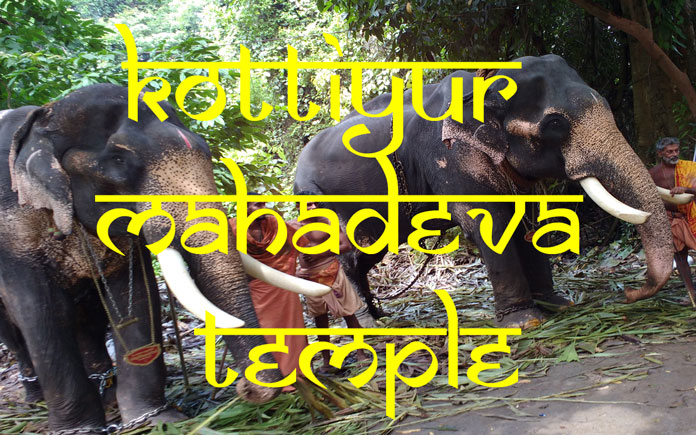
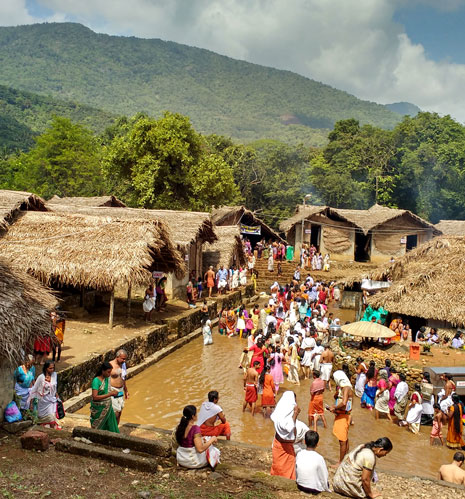
KOTTIYUR MAHADEVA TEMPLE
(Akkara Kottiyoor Mahadeva Temple)
(Akkara Kottiyoor Mahadeva Temple)
Kottiyur Shiva temple is really a misnomer because actually speaking no
temple exists or shall I say two temples of the same name exist. One
can always be visited but the other “appears” only in the month of
Vaishakam. Without knowing anything, only due to His grace it so
happened that our little party arrived at that spot at the correct
time. Now to give some idea of what I am talking about let me dilate on
the legend.
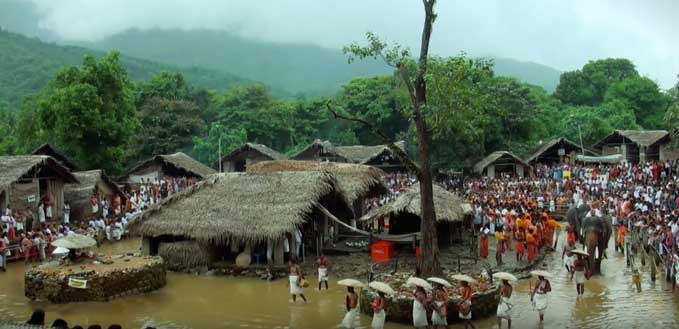
This ancient temple of Shiva is in Kannur district. It is in the valley of the Sahya range. The Bavali River, filled with medicinal waters flows from the Wayanad Ghats and passes near the temple. On the north side of this river there is a small lake known as Thiruvanchira and in the midst of this lake is the temple which has no permanent building of any sort since it’s covered by water most of the time. In the middle of this lake is a small stone which is swayambhu or self born, (not installed by human hands). This is found on a big slab known as Manithara and is the centre of attraction during the month of Vaishakam during which the waters of the lake dry up to ankle deep and thus allow devotees to worship the Lord. In the same lake close to this, is another small linga known as Ammarakallu where Parvati is worshipped. This temple is known as Akkara (opposite bank) Kottiyur and as I said it is open only during the month of Vaishakam. The original temple on the other bank of the river on the main road is known as Ikkare (on this bank) Kottiyur.
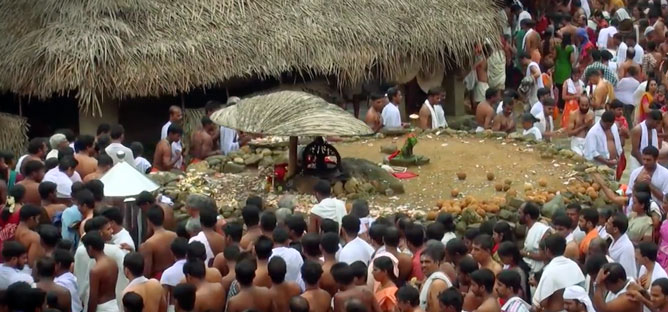
Kottiyur is actually said to be the place of the Daksha Yaga. In the North people believe that Kankhal, near Haridwar is the place of the Daksha Yaga. Daksha was one of the Prajapatis or patriarchs and his daughter Sati had married Lord Shiva. For some reason Daksha felt he had been insulted by his son-in-law and in order to take revenge he started a huge yaga to which he deliberately did not invite Shiva and Sati. However Sati went to her father’s yaga against Shiva’s wish and her father refused to give her a seat or even look at her face. She also noticed that no offering had been made for Shiva. Enraged at this she cursed her father and decided to abandon the body which had come from Daksha. She immolated herself in the fire of austerity. Kottiyur is the place where she is supposed to have done this. Shiva was enraged when he heard this and sent his ferocious general, Veerabhadra along with a host of ganas (Shiva’s entourage) to destroy the yaga. This was ruthlessly done and Daksha’s head was also cut off. Since the yaga had come to an ignominious end, the gods feared that negative effects would soon be felt in the world, so Brahma and Vishnu along with the other gods went to Kailasa to beg Shiva to restore the yaga and complete it. Shiva went with the other gods and restored the yaga. All the other gods returned to their own abodes but Shiva who was bemoaning the loss of his beloved wife, Sati, stayed back in the form of a swayambhu linga next to where Sati had immolated herself. This is the linga which is worshipped here and the Ammarakallu is the place where Sati had immolated herself. Since the trimurtis (trinity) in the form of Brahma, Vishnu and Shiva met in this place it came to be known as Koodiyur. “Koodi” in Malayalam means to meet or join. This later became Kottiyur. One of the famous offerings here is a strange looking thing which is made of the tender stem of the bamboos which grow in abundance here and is supposed to be the beard of Daksha. Actually it does look very much like a gray beard.
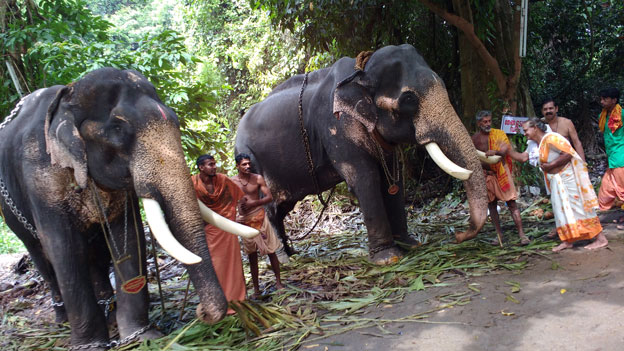
This lake is supposed to be the yajna bhoomi or place where the ancient Vedic yajna took place. In fact the original name of the lake was “rudiram chira” or lake of blood. This was later corrupted to form the word Thiru-vanchira. “Thiru” means “auspicious.”
Every year in the month of Vaishakam a twenty-eight day pilgrimage is observed to which thousands of pilgrims come. In fact it is something like the pilgrimage made to Sabarimala in the month of Makaram or the Kumbh Mela in Prayag.
Of course this place has no sreekovil/garbhagriha (sanctum sanctorum). Everything takes place on a raised platform made out of the stones from the river known as the Manithara. Temporary thatched huts are erected every year and removed at the close of the festival and thrown into the lake. The lake has a spring from which water flows towards the Bavali River to the west. The Manithara is located at the center of this lake. The entire shrine actually looks like a Shivalinga itself if viewed from above. There is another raised circular platform beside the main shrine known as Ammarakallu where Sati had immolated herself. In front is the giant, Jayanti vilakku, or lamp and an idol covered by a palmyra leaf umbrella, which used to be popular in Kerala before the advent of the modern umbrellas. All the rites and rituals observed during these 28 days were laid down by Adi Shankaracharya.
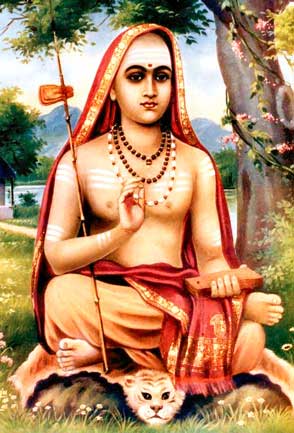
Of course this story took place in Vedic times. During the course of
years the forest had completely overgrown the whole place and the only
human beings who roamed around were the tribals or Adivasis. A few
centuries ago it is said that one of them when he was out hunting,
wanted to sharpen his knife. He spied a shining stone on which he
started to whet his knife and very soon a fountain of blood spurted out
of the stone. He was terrified and ran through the dense jungle to the
Namboodiri (Kerala Brahmin) who was supposed to know all about esoteric
happenings. The Namboodiri collected the chiefs of five of the
prominent Nair families and they ran to the site where blood was still
spouting. He immediately asked for milk and ghee to be brought and
poured it over the stone but however much he poured the blood would not
stop. Just then one of the tribals arrived carrying a bunch of tender
coconuts. The Namboodiri immediately asked him to cut a coconut and
give it to him. He did abhishekam (ceremonial bath) with this tender
coconut water and immediately the bleeding stopped. After that he
applied sandal paste etc. Since then the ceremonial washing of the
lingam is always done with tender coconut water, milk and ghee.
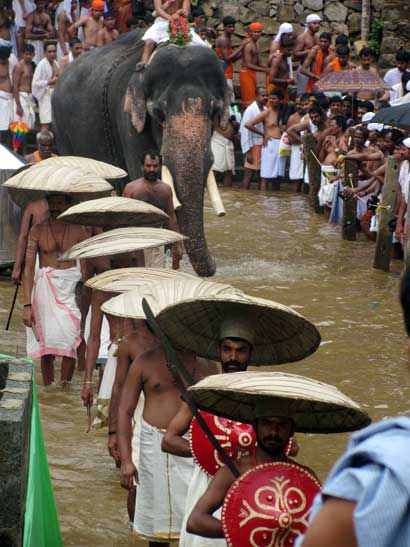
It was our great good fortune that we were able to go to this temple after our tour of Wyanad and thus see all these wonderful sights for ourselves. From the town we had to park the car and cross the Baveli River over a bridge. Actually most pilgrims take a bath in this river before proceeding. A strange thing was pointed out to us about the small stones found in the river. If you rub them on a stone sometimes, you will get some red paste and sometimes white, denoting Shiva and Parvati. Shiva of course is always adorned with white ashes (vibhuti) and Parvati with vermilion (kum-kum). From the river we had to climb a slope. Two caparisoned elephants were taking rest on the side as we climbed up. On top we could survey the lake below with the temporary huts and the make-shift arrangement round the two stones. There was a huge peepul tree under which offerings were being sold. We climbed down to the lake and had to circumambulate the shrine within the pond, with feet sloshing ankle deep in the water. There was a slight drizzle. But very soon a hot sun came up. There was a huge crowd and we were made to queue up on a side. People were coming from the other side also so groups were let in alternately. Everything was very orderly and there was no pushing and shouting. The helpers were many and most helpful! At last we reached the ammarakallu and the Swayambhu lingam but of course there was no time to observe too closely. Even though the helpers did not shout or push as in many temples, yet we were encouraged to take the prasadam and quickly move forward as so many people wanted to take darshana. Actually the people who were with us told us that we were most fortunate since the queue was so short. Normally it would stretch right up to the bridge. It was only Shiva’s grace that we were able to have this amazing experience. Sri is a great Shiva bhakta and I feel its her good fortune that we were able to go there. Aum Namashivaaya

This ancient temple of Shiva is in Kannur district. It is in the valley of the Sahya range. The Bavali River, filled with medicinal waters flows from the Wayanad Ghats and passes near the temple. On the north side of this river there is a small lake known as Thiruvanchira and in the midst of this lake is the temple which has no permanent building of any sort since it’s covered by water most of the time. In the middle of this lake is a small stone which is swayambhu or self born, (not installed by human hands). This is found on a big slab known as Manithara and is the centre of attraction during the month of Vaishakam during which the waters of the lake dry up to ankle deep and thus allow devotees to worship the Lord. In the same lake close to this, is another small linga known as Ammarakallu where Parvati is worshipped. This temple is known as Akkara (opposite bank) Kottiyur and as I said it is open only during the month of Vaishakam. The original temple on the other bank of the river on the main road is known as Ikkare (on this bank) Kottiyur.

അമ്മാറക്കല്ല് Ammarakallu , where Parvati Devi is worshiped, as Sati
Kottiyur is actually said to be the place of the Daksha Yaga. In the North people believe that Kankhal, near Haridwar is the place of the Daksha Yaga. Daksha was one of the Prajapatis or patriarchs and his daughter Sati had married Lord Shiva. For some reason Daksha felt he had been insulted by his son-in-law and in order to take revenge he started a huge yaga to which he deliberately did not invite Shiva and Sati. However Sati went to her father’s yaga against Shiva’s wish and her father refused to give her a seat or even look at her face. She also noticed that no offering had been made for Shiva. Enraged at this she cursed her father and decided to abandon the body which had come from Daksha. She immolated herself in the fire of austerity. Kottiyur is the place where she is supposed to have done this. Shiva was enraged when he heard this and sent his ferocious general, Veerabhadra along with a host of ganas (Shiva’s entourage) to destroy the yaga. This was ruthlessly done and Daksha’s head was also cut off. Since the yaga had come to an ignominious end, the gods feared that negative effects would soon be felt in the world, so Brahma and Vishnu along with the other gods went to Kailasa to beg Shiva to restore the yaga and complete it. Shiva went with the other gods and restored the yaga. All the other gods returned to their own abodes but Shiva who was bemoaning the loss of his beloved wife, Sati, stayed back in the form of a swayambhu linga next to where Sati had immolated herself. This is the linga which is worshipped here and the Ammarakallu is the place where Sati had immolated herself. Since the trimurtis (trinity) in the form of Brahma, Vishnu and Shiva met in this place it came to be known as Koodiyur. “Koodi” in Malayalam means to meet or join. This later became Kottiyur. One of the famous offerings here is a strange looking thing which is made of the tender stem of the bamboos which grow in abundance here and is supposed to be the beard of Daksha. Actually it does look very much like a gray beard.

This lake is supposed to be the yajna bhoomi or place where the ancient Vedic yajna took place. In fact the original name of the lake was “rudiram chira” or lake of blood. This was later corrupted to form the word Thiru-vanchira. “Thiru” means “auspicious.”
Every year in the month of Vaishakam a twenty-eight day pilgrimage is observed to which thousands of pilgrims come. In fact it is something like the pilgrimage made to Sabarimala in the month of Makaram or the Kumbh Mela in Prayag.
Of course this place has no sreekovil/garbhagriha (sanctum sanctorum). Everything takes place on a raised platform made out of the stones from the river known as the Manithara. Temporary thatched huts are erected every year and removed at the close of the festival and thrown into the lake. The lake has a spring from which water flows towards the Bavali River to the west. The Manithara is located at the center of this lake. The entire shrine actually looks like a Shivalinga itself if viewed from above. There is another raised circular platform beside the main shrine known as Ammarakallu where Sati had immolated herself. In front is the giant, Jayanti vilakku, or lamp and an idol covered by a palmyra leaf umbrella, which used to be popular in Kerala before the advent of the modern umbrellas. All the rites and rituals observed during these 28 days were laid down by Adi Shankaracharya.


It was our great good fortune that we were able to go to this temple after our tour of Wyanad and thus see all these wonderful sights for ourselves. From the town we had to park the car and cross the Baveli River over a bridge. Actually most pilgrims take a bath in this river before proceeding. A strange thing was pointed out to us about the small stones found in the river. If you rub them on a stone sometimes, you will get some red paste and sometimes white, denoting Shiva and Parvati. Shiva of course is always adorned with white ashes (vibhuti) and Parvati with vermilion (kum-kum). From the river we had to climb a slope. Two caparisoned elephants were taking rest on the side as we climbed up. On top we could survey the lake below with the temporary huts and the make-shift arrangement round the two stones. There was a huge peepul tree under which offerings were being sold. We climbed down to the lake and had to circumambulate the shrine within the pond, with feet sloshing ankle deep in the water. There was a slight drizzle. But very soon a hot sun came up. There was a huge crowd and we were made to queue up on a side. People were coming from the other side also so groups were let in alternately. Everything was very orderly and there was no pushing and shouting. The helpers were many and most helpful! At last we reached the ammarakallu and the Swayambhu lingam but of course there was no time to observe too closely. Even though the helpers did not shout or push as in many temples, yet we were encouraged to take the prasadam and quickly move forward as so many people wanted to take darshana. Actually the people who were with us told us that we were most fortunate since the queue was so short. Normally it would stretch right up to the bridge. It was only Shiva’s grace that we were able to have this amazing experience. Sri is a great Shiva bhakta and I feel its her good fortune that we were able to go there. Aum Namashivaaya